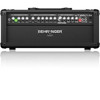Behringer VIRTUBE VT100FXH Manual - Page 6
Rear panel - virtube
 |
View all Behringer VIRTUBE VT100FXH manuals
Add to My Manuals
Save this manual to your list of manuals |
Page 6 highlights
6 VIRTUBE VT250FX/VT100FX/VT50FX/VT100FXH User Manual (13) With the MIDDLE control (VT100FXH and VT100FX only) you can raise or lower the midrange frequencies on the OVERDRIVE channel. (14) The TREBLE control adjusts the treble frequencies on the OVERDRIVE channel. (15) Use the CONTOUR control for additional, highly characteristic adjustment of the midrange, allowing you to easily create traditional as well as ultra-modern guitar sounds. (16) The VOLUME control adjusts the volume level of the OVERDRIVE channel. 2.1.3 DIGITAL FX (17) The DIGITAL FX LED lights up when the effects processor is active. (18) Use the FX PRESET control to select one of 16 effects. Preset 1 - 4 5 - 8 9 - 12 13 - 16 Tab. 2.1: Effects FX Chorus/Delay Delay Chorus Flanger (19) The FX LEVEL control adjusts the mix ratio between the original and the effect signal. (20) The REVERB LEVEL control determines the effect intensity of the additional reverb effect. (21) The FX LOOP MIX control (VT100FXH and VT100FX only) determines the effect intensity of the external effect (see Chapter 2.2.1 FX LOOP). 2.1.4 MASTER section (22) The MASTER VOLUME control adjusts both the overall volume and the line out/headphones volume. (23) The VTC push button activates and deactivates the VTC Virtual Tube Circuitry. (24) The CD IN connector allows you to connect the output signal of a CD player, tape deck, or CD/MD walkman. For example, you can play back music CDs or CDs accompanying a guitar tutor while practising. This connector can also be used as a LINE OUT output. In this case, the guitar signal is output with no speaker simulation applied and can be routed to an external amp or mixing console. This will not mute the VIRTUBE's built-in loudspeaker. (25) The LINE OUT/PHONES jack is for headphones connection. Internal speaker simulation is applied to the headphones signal in order to produce an authentic signal. The VIRTUBE's built-in loudspeaker is muted when this connector is used. ◊ The headphones output signal can also be routed to a mixing console or other sound reinforcement system. To do so, connect the headphones output with the line input on the mixing console. Use a standard cable with 1/4" TS connectors. If hum problems occur, you could insert a DI box, e.g. BEHRINGER ULTRA-DI DI100 or DI120. ◊ Some headphones tend to produce distortion with too high volume level. Please turn down the volume a bit, until distortion stops. (26) The POWER switch turns your VIRTUBE on and off. It should always be in the OFF position when connecting the unit to the mains. ◊ Please note: Merely switching the unit off does not mean that it is fully disconnected from the mains. To disconnect the unit from the mains, pull out the mains connector. Before installation, please make sure that the mains connector has not been damaged. If you do not use the unit for an extended period of time, please disconnect it at the mains. (28) (30) (35) (27) Fig. 2.2: VIRTUBE control elements (rear panel) (29) (33) (31) (32) (34) 2.2 Rear panel (27) The VIRTUBE is connected to the mains using a standard IEC receptacle. A suitable power cord is included with the unit. (28) FUSE HOLDER/VOLTAGE SELECTOR. Before connecting the unit to the mains, ensure that the voltage setting matches your local voltage. Blown fuses must be replaced with a fuse of the same type and rating. On some units, the fuse holder can be switched to one of two positions, i.e. 230 V and 120 V. Please note: when operating the unit outside Europe at 120 V, a higher fuse rating is required (see Chapter 4, "Installation"). (29) This is where the fan of the unit is located. (30) The SPEAKER OUT connectors (only one on the VT100FX and VT50FX) can be used to connect external speakers with a miminum impedance of 4 Ω. The outputs of the VT250FX deliver 50 Watts of power per channel (L/R). Always use speakers with a minimum impedance of 8 Ω to ensure maximum power output. Using the SPEAKER OUT connectors will mute the built-in loudspeakers. 2.2.1 FX LOOP (31) The FX LEVEL button allows you to adapt the FX LOOP to the operating level of an external effects device (+4 dBu/-10 dBV). (32) The VIRTUBE provides a serial insert path for inserting external effects (e.g. reverb processor). To do so, connect the FX SEND jack to the input of the effects device. ◊ The FX SEND can also be used as a parallel output with no effects, for example, to record a "dry" guitar signal. As long as the RETURN jack is not in use, there will be no break in the internal signal path.















